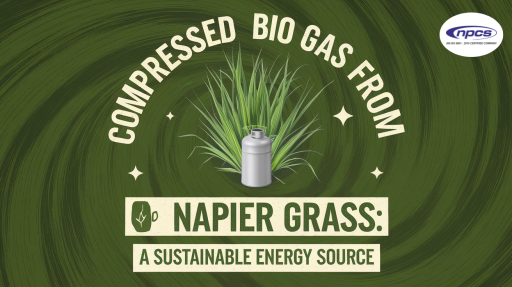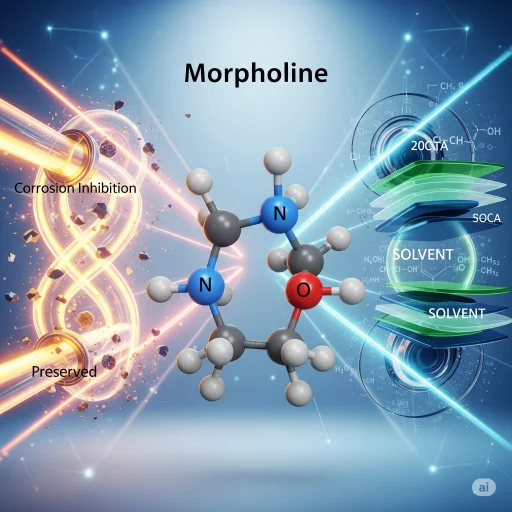Bioenergy operates as a strategic tool to reduce fossil fuel dependence since the world accepts sustainable energy alternatives. The popularity of compressed biogas keeps growing among different bioenergy options because it provides a suitable substitute for traditional natural gas while reducing greenhouse gas emissions. The production of biogas benefits from the use of Napier grass which grows rapidly but achieves moderate efficiency. The research explains Napier grass-derived compressed biogas generation through its supporting environmental and financial elements and sustainability aspects for future energy systems.
What is Compressed Biogas (CBG)?
The fuel known as compressed biogas (CBG) emerges from organic waste through anaerobic digestion to create a sustainable and environmentally friendly product. The process of oxygen deprivation enables microbes to break down organic molecules which results in biogas production consisting of methane (CH₄), carbon dioxide (CO₂) and minimal quantities of various gas traces. Storage and transportation of biogas becomes possible for fuel consumption by compressing the clean gas under high pressure.
Natural gas consumption finds a renewable replacement in CBG which emits minimal greenhouse gas emissions during combustion because of its renewable nature and low atmospheric pollutants.
Read More About : Compressed Biogas
An Excellent Feedstock for Biogas Production: Napier Grass
Napier grass or Pennisetum purpureum serves as a biomass source for bioenergy production particularly when referred to as elephant grass. The grass produces well in diverse African environmental conditions and exhibits traits that would enable successful growth across various other nations. The sustainable use of Napier grass for biogas production gets enhanced because of its fast growth together with abundant yields and successful growth on marginal land areas.
Napier grass stands out among biobased crops for energy use because it needs minimal water supplies and fertilizer applications together with low requirements for chemical pest control. Farmers who wish to improve their profits through renewable energy solutions find high value in this approach.
Compressed Biogas a Step-by-Step Procedure
Valuation of compressed biogas from napier grass begins by focusing on cultivation followed by harvesting before anaerobic digestion then purification until the end process of compression.
- Harvesting and Cultivation
The main agricultural value of napier grass stems from its high biomass production yield. Periodically the grass is cut down for processing at the biogas plant where leaves and stems are used as feedstock. The short growth period of Napier grass (4 to 6 months) makes it the best plant material to produce biogas.
Napier grass proves suitable for growth on different soil types ranging from poor to rich. Such areas provide farmers with napier grass as an effective method to boost their earnings. The acquired biomass proceeds to a biogas conversion process.
- Anaerobic D digestion
Napier grass receives placement in anaerobic digesters that serve as tightly sealed tanks which enable organic waste breakdown through the absence of oxygen. following collection. Microorganisms process cellulose, hemicellulose and additional grass components to create simpler organic compounds which result in methane as the main energy product during the process.
The anaerobic digestion process yields two outputs including biogas and digestate along with its nutritive value that transforms into an organic fertilizer for agricultural purposes. Organic fertilizer production through sustainable farming increases when demand for artificial fertilizers reduces.
- Compression and Cleanliness
Raw gas produced by digesters consists mainly of water vapor combined with hydrogen sulfide and carbon dioxide and other contaminants. An elimination stage needs to remove all pollutants from the biogas before fuel burning becomes possible. Biogas purification results in compressed biogas which reaches pressures between 200 to 250 bars. This compaction facilitates transportation and storage of the gas.
Read More About : Why the Business of Bio CNG Gas is in High Demand?
Compressed Biogas from Napier Grass: Environmental and Financial Advantages
Reduction in Greenhouse Gas Emissions
Reduced greenhouse gas emissions are one of the main benefits compressed biogas offers for the environment. Burning conventional fossil fuels—coal or natural gas—sully the atmosphere with enormous carbon dioxide and other pollutants. Because the carbon absorbed by the Napier grass during growth balances the carbon dioxide emitted during combustion, CBG is a carbon-neutral fuel.
Consequently, the burning of the biomass from Napier grass will also help to lessen open burning of agricultural wastes. Many areas, where it is a significant source of air pollution and greenhouse gasses, have this exceptional commonness. Conversion of napier grass into CBG will help to minimize these emissions, therefore guaranteeing better air and a reduced global warming impact.
Also Know About : Biomass resources and biofuels potential Archives
Waste Management and Circular Economy
By bringing agricultural waste and byproducts back into value as energy, the generation of CBG from Napier grass supports a circular economy turn around. cultivating Napier grass, for instance, might be a paradigm for agricultural waste management whereby crop wastes are turned into biogas for usage in areas cultivating Napier grass. Using the high-quality fertilizer produced by anaerobic digestion closes the cycle and lessens dependency on synthetic fertilizers.
Apart from trash reduction, biogas plants would be a source of rural electrician employment and enhance their local economy, particularly in Napier grass-growing areas. In both environmental and financial perspectives, this is thus the win-win scenario of biogas generating.
Local Energy Production: Energy Security
Therefore, compared to big power plants, CBG may be created at low cost and great rates. This suggests localized energy generation meant to improve rural energy security. This will help the community to become resilient against changing energy market prices and de-link it from imported fossil fuels. From running cars to producing power, CBG also finds usage in a range of other sectors.
Difficulties and opportunities Ahead
Even with these advantages, broad acceptance of CBG from Napier grass still presents certain difficulties. Together with the infrastructure for biogas compression and distribution, initial capital expenditure to build biogas facilities might be somewhat significant.
Nonetheless, given the growing interest in renewable energy combined with government and institutional support for encouraging energy solutions. There is a huge anticipation in the bright future of CBG from Napier grass in the energy mix of the globe. Thus, research and additional development in biogas technology. Combined with improved legislation.Financial incentives might alleviate these issues. Possibly assist to maximize the potential of CBG as a clean and sustainable energy source.
Project Related To : Compressed Biogas Plant
Conclusion
Compressed biogas derived from Napier grass offers financial and environmental advantages as well as a sustainable energy supply. Such CBG generation from a fast-growing, low-input crop might be a feasible route toward sustainable energy. With mitigating effects toward the induction of greenhouse emissions, waste management, and energy security. CBG from Napier grass could find an opportunity to be one of the main participants in the shift toward a more sustainable. Low-carbon global energy future as technology develops and the world advances toward support for bio-energy.






